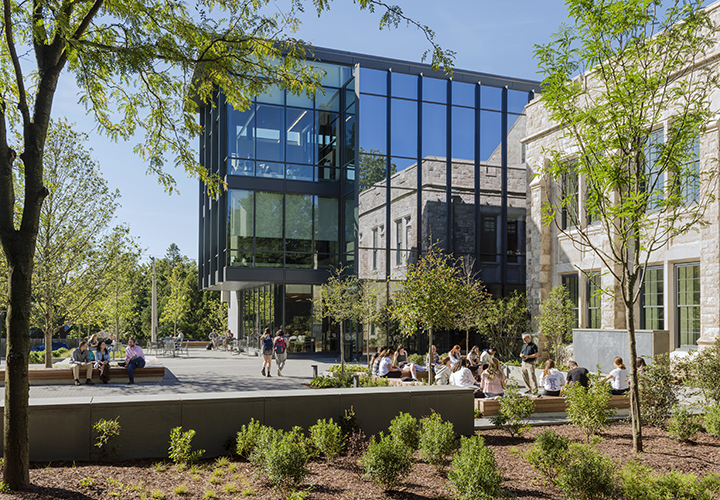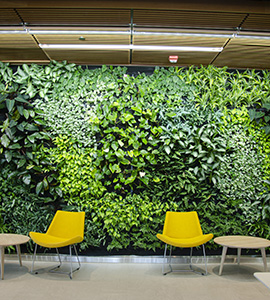Loyola’s new academic building for innovation and collaborative learning receives LEED Gold Certification

Loyola University Maryland’s Miguel B. Fernandez Family Center for Innovation and Collaborative Learning has received the Leadership in Energy and Environmental Design (LEED) Gold Certification from the U.S. Green Building Council (USGBC)— a designation awarded to environmentally sustainable buildings.
“This recognition for the Fernandez Center is a wonderful sign of Loyola’s ongoing—and
growing—commitment to sustainability,” said Terrence M. Sawyer, J.D., president of
Loyola. “Advancing our work in this area is a mission-based priority for us as a Jesuit,
Catholic university, especially as a designated Laudato Si’ institution. As a community, we are working to make tangible progress in caring for our common
home.”
The Fernandez Center, which was opened in September 2021, is the first academic building on Loyola’s Evergreen campus to receive this certification. Receiving 60 points to achieve its LEED Gold recognition, the building is equipped with advanced storm water management infrastructure, highly efficient heating, cooling and lighting systems, and sustainable fixtures and appliances. It is expected to cost 40% less to operate compared to a conventional design, reducing pressure on the University’s utilities budget.
“The LEED Gold certification for the Fernandez Center affirms our continuous progress in implementing Loyola’s climate action plan and our desire to reduce energy consumption by 20% by 2030,” said Meredith Sullivan, director of project management. “This building is part of a long-term strategy to reduce our carbon footprint and engage our community in action on climate change. We expect to leverage our experience at the Fernandez Center to pursue future green building initiatives on campus.”
LEED is the most widely used green building rating system in the world. Available for virtually all building, community, and home project types, LEED provides a framework to create healthy, highly efficient, and cost-saving green buildings. LEED certification is a globally recognized symbol of sustainability achievement.
“Loyola University Maryland’s LEED certification demonstrates tremendous green building leadership,” said Peter Templeton, president and CEO of USGBC. “LEED was created to make the world a better place and revolutionize our buildings and communities by providing everyone with access to healthy, green, and high performing buildings. Loyola is a prime example of how the innovative work of project teams can create local solutions that contribute to making a global difference.”
Loyola is committed to sustainable design and construction that meets or exceeds USGBC’s LEED Gold rating, or equivalent. The University will look to the U.S. Green Building Council's LEED framework with the goal of achieving a LEED Gold rating for each new building or major renovation project. Read more about Loyola’s Green Building Policy efforts on campus.
More about the U.S. Green Building Council
The vision at the U.S. Green Building Council (USGBC) is that buildings and communities will regenerate and sustain the health and vitality of all life within a generation. The USGBC mission is to transform the way buildings and communities are designed, built and operated, enabling an environmentally and socially responsible, healthy, and prosperous environment that improves the quality of life.
Contributors to Loyola’s LEED Gold certification include:
Architect and Interior Designer: Shepley Bulfinch
Landscape Architect: Hord Coplan Macht
Civil Engineer: Whitney Bailey Cox & Magnani, LLC
MEP Engineer: Mueller Associates
LEED Consultant: Thornton Tomasetti
Contractor: Whiting Turner
Commissioning Agent: Colliers Project Leaders
Structural Engineer: Hope Furrer
Lighting Designer: Lewis Lighting Design
Energy Modeling: Sustainable Building Partners